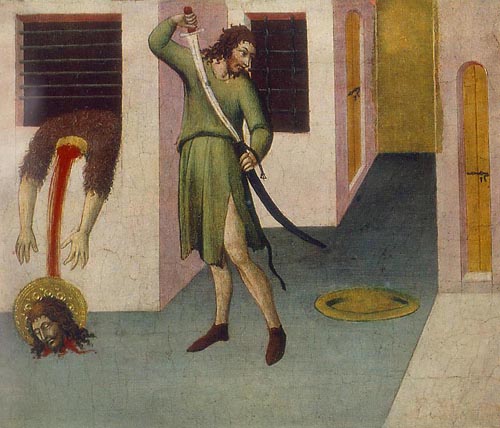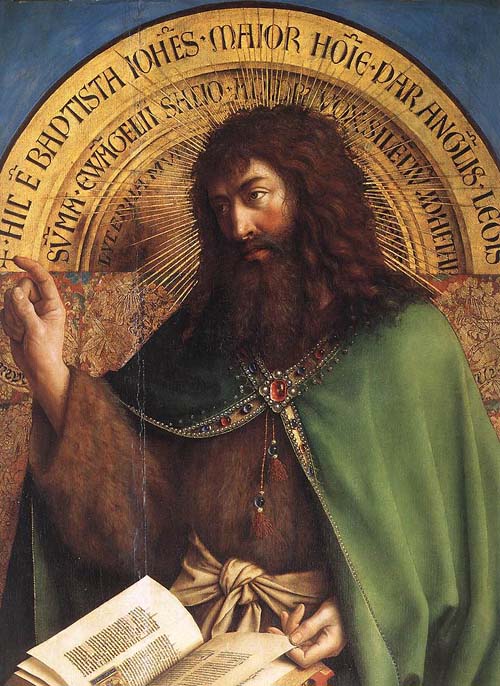
15th Century Italian painting of John the Baptist’s beheading. By Pietro di Sano.
This picture makes John’s execution almost look like an unfortunate accident. Somehow sticking his head through the window -was he trying to escape?- led to a lethal injury. If course that’s if we ignore the man in the middle with the perfectly clean sword. A scimitar, no less, indicating the exotic origins of this person -despite of the Roman regime that had decided on the prophet’s fate. He’s looking at the golden platter. His job is not done yet. I wonder if he’s thinking about how he’s going to fit John’s aureole on that thing. It too looks like it’s made of solid gold. Is that why his head fell off? From the weight of his holiness? Or did it have a sharp edge perhaps? This would certainly explain the cleanliness of the scimitar.
John was wearing his typical outfit of camel’s hair (as described in the Bible by Matthew), often interpreted by medieval artists as camel skin. But in all likelihood, he probably wore woven clothing. And a camel’s hair is probably very rough, indicating a certain inclination towards masochism in the prophet, not atypical for Christian martyrs.
A much more dignified depiction of the saint comes from Jan van Eyck, painted a bit earlier in the same century.

Detail of the 15th century Flemish Alter Piece depicting John the Baptist. Painted by Jan van Eyck.
Judging by the rich cape that covers his camel skin dress, this is probably a portrayal of John the Baptist after his death, in heaven. Looks like Salomé didn’t get to keep the head, after all. And now it is even surrounded by a magnificent aureole of golden rays.
It’s beautiful.
To think that this amazing piece of work is only one part of a much larger, much more complex and breathtakingly marvelous piece that is located at 10 minutes walking from my door! In Saint-Bavo’s Cathedral in Ghent.
Who needs death when heaven is so nearby?
The picture of John the Baptist apparently got stolen together with the panel of The Just Judges. The latter was never recuperated, which is a shame. But I hate how this stupid so called mystery of the lost panel overshadows the splendor of the masterpiece. I mean: it’s got a lamb on a table with blood coming out of its chest!!!
Saint-Bavo’s Cathedral, by the way, is probably the one work of art that has influenced our own practice most. Not just the altar piece, but the entire cathedral, from its gothic architecture and its dramatic staging of baroque decorations to all the paintings and sculptures in it, ranging from the sublime to the banal. In this cathedral we started thinking about non-linear storytelling in three dimensional space.
It must be great living only a few minutes away from a van Eyck brothers masterpiece… I’ve spent hours looking at mere representations of those panels on books. So many details evade me in these representations: tell me, how close can one actually get to those panels for careful observation?
You are very fortunate. And inspired.
The presentation of The Mystic Lamb in the church is a bit awkward. It sits in a giant kind of aquarium in a small room. It’s not pretty as such but I do like that they treat it as an object, rather than a picture. The back of the thing (or actually the front side of the doors) also has paintings on it. A beautiful annunciation with a giant angel Gabriel, for instance. It’s such a crazy beautiful painting. I too have spent lots of time looking at reproductions. Of course the physicality of the object has its own effect. It’s rather huge.
Again, a format (like the Tondo) that would be a welcome importation from painting to videogame – can you imagine a game played in that polyptych panel format? I sure can.
So many ideas, so little time.
The sword in the first painting is probably clean because he’s putting it away, you don’t put a blood-soaked sword back in it’s sheath!
The van Eyck is extraordinary.
I wonder what John is thinking… there’s so much depth in his eyes.